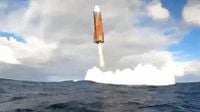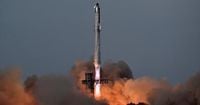SpaceX achieved a major milestone on August 26, 2025, as its Starship rocket completed a triumphant 10th test flight, breaking a string of high-profile setbacks and invigorating hopes for the future of human space exploration. The launch, which took place at 7:30 p.m. Eastern Time from the company’s Starbase facility in South Texas, marked a turning point for the world’s most powerful rocket and spacecraft combination, according to multiple sources including ABC News, CBS News, and NPR.
The towering, stainless steel Starship—standing about 400 feet tall when stacked atop its Super Heavy booster—roared off the launch pad, powered by 33 Raptor engines that generated a staggering 16 million pounds of thrust. This power dwarfs even NASA’s legendary Saturn V and the Space Launch System, as noted by CBS News. The rocket’s thunderous ascent was a spectacle, watched with bated breath by engineers, space enthusiasts, and the global space community, all keenly aware of the mission’s significance after a year marked by technical mishaps and fiery explosions.
This flight was more than just another test. SpaceX had twice delayed the launch due to problems with ground equipment and unfavorable weather, but clear skies on Tuesday set the stage for a mission that would finally check off several key objectives. As NPR reported, the spacecraft reached space on a suborbital trajectory, something that had eluded the last three test flights. The upper stage, Starship, successfully deployed eight Starlink satellite simulators using a mechanism reminiscent of a gigantic PEZ dispenser—a first for the company. “The last one has been deployed,” SpaceX webcast commentator Dan Huot announced, to the cheers of the SpaceX team. “Heck yeah, everybody!”
Another critical milestone was achieved when Starship relit one of its six Raptor engines while in space, a feat crucial for future orbital missions and one that had failed in previous attempts. After completing its tasks, the spacecraft re-entered Earth’s atmosphere, testing a new batch of heat shield tiles and the resilience of its control flaps. Cameras captured dramatic footage as reentry heating damaged a protective skirt around the engines and partially melted a control flap near its hinge. Still, the vehicle remained under control, flipping and maneuvering as designed, before executing a landing burn and splashing down in the Indian Ocean, west of Australia, just over an hour after liftoff.
The splashdown, though followed by an explosion, was anticipated. Starship is not designed for water landings, and the breakup was considered part of the test, not a failure. A buoy camera stationed in the ocean captured the moment, and SpaceX celebrated the achievement with a post on X: “Splashdown confirmed! Congratulations to the entire SpaceX team on an exciting tenth flight test of Starship!”
Meanwhile, the Super Heavy booster, which had propelled Starship out of the lower atmosphere, performed a soft splashdown in the Gulf of Mexico. In a deliberate test of the rocket’s redundancy, one of the three engines used during the booster’s powered descent was intentionally shut down. The booster compensated smoothly, landing as planned despite the loss, as described by CBS News. This success was particularly sweet after a series of previous flights ended in rapid unscheduled disassembly—a technical term for catastrophic failure—or were cut short by hardware malfunctions.
SpaceX’s journey to this point has been anything but smooth. In mid-June, a Starship exploded on the launch pad during a pre-flight engine test, traced back to the failure of a pressurized tank storing gaseous nitrogen. Earlier in the year, test flights were marred by fuel leaks, unexpected vibrations, and even the spectacular destruction of the rocket during landing attempts. Debris scattered across wide areas, and at one point, airports in South Florida and the Atlantic region were forced to temporarily halt operations.
Yet, each failure has been met with rapid iteration and improvement. SpaceX has implemented “hardware and operational changes” to enhance the reliability of both Starship and the Super Heavy booster, according to a company statement cited by ABC News. The company’s aggressive test schedule and willingness to push the envelope—sometimes literally removing heat tiles to see what happens—are central to its engineering philosophy. As Carissa Christensen, CEO of BryceTech, told NPR, “Starship is in many ways the flagship SpaceX program right now.”
Elon Musk, SpaceX’s CEO and chief engineer, has remained candid about the immense challenge of creating a fully reusable rocket. “There is a reason no fully reusable rocket has been built—it’s an insanely hard problem. Moreover, it must be rapidly & completely reusable (like an airplane). This is the only way to make life multiplanetary,” Musk wrote on X. During a May presentation, he doubled down on his vision: “Each launch is about learning more and more about what’s needed to make life multiplanetary and to improve Starship to the point where it can be taking ultimately hundreds of thousands, if not millions, of people to Mars.”
The stakes are high not just for SpaceX, but for NASA as well. The agency is counting on a modified version of Starship to land astronauts on the moon as early as 2027. But as CBS News points out, significant technical hurdles remain. To fuel a lunar lander variant, SpaceX will need to launch up to 20 tanker flights to transfer cryogenic propellants in orbit—something never before attempted. Each launch adds risk, and a single failure could jeopardize the entire mission. Landing a 16-story rocket on the moon’s uneven surface is another daunting challenge, with the potential for a dangerous tip-over if the terrain is unstable.
Industry experts interviewed by CBS News are skeptical that a crewed Starship moon landing will happen by 2027—or even by 2030—without major changes to the program’s architecture. One senior engineer involved in NASA’s Artemis program commented, “We are not going to go ahead and get a crewed Starship to the moon by 2030, under any circumstances. That doesn’t mean they’ll never get there. That doesn’t mean the architecture couldn’t work. But it’s just too big of a technical leap to accomplish in the short time that we’ve got.”
Despite the doubts and the daunting list of engineering challenges, SpaceX’s 10th Starship flight has injected new optimism into the program. The company’s relentless drive, its capacity for rapid iteration, and its willingness to learn from failure have set it apart in the modern space race. As NASA’s human-rating certification process looms—a rigorous gauntlet requiring proof of safety, reliability, and abort capability—SpaceX will need to deliver not just one, but many more successful flights before Starship is cleared to carry humans to the moon, Mars, and beyond.
For now, the successful 10th test flight stands as a testament to SpaceX’s resilience and ambition, and a reminder that the path to the stars is paved with both setbacks and spectacular triumphs.






